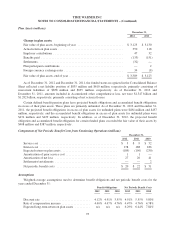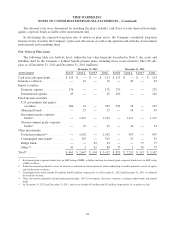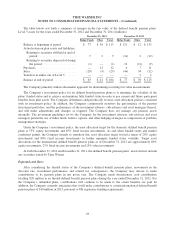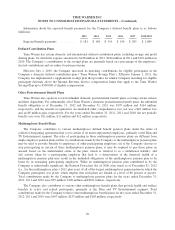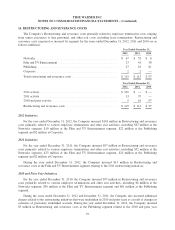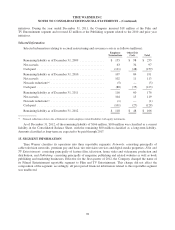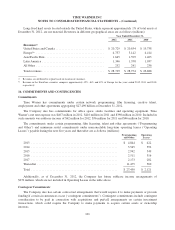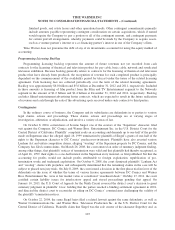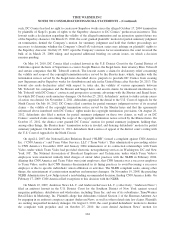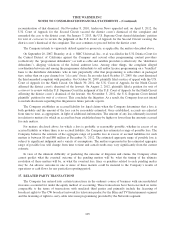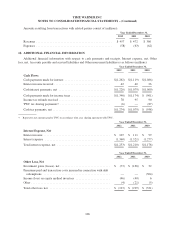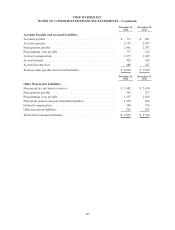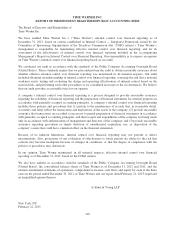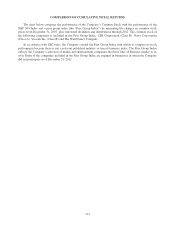Time Magazine 2012 Annual Report Download - page 119
Download and view the complete annual report
Please find page 119 of the 2012 Time Magazine annual report below. You can navigate through the pages in the report by either clicking on the pages listed below, or by using the keyword search tool below to find specific information within the annual report.TIME WARNER INC.
NOTES TO CONSOLIDATED FINANCIAL STATEMENTS – (Continued)
finished goods, real estate leases and other operational needs. Other contingent commitments primarily
include amounts payable representing contingent consideration on certain acquisitions, which if earned
would require the Company to pay a portion or all of the contingent amount, and contingent payments
for certain put/call arrangements, whereby payments could be made by the Company to acquire assets,
such as a venture partner’s interest or a co-financing partner’s interest in one of the Company’s films.
Time Warner does not guarantee the debt of any of its investments accounted for using the equity method of
accounting.
Programming Licensing Backlog
Programming licensing backlog represents the amount of future revenues not yet recorded from cash
contracts for the licensing of theatrical and television product for pay cable, basic cable, network and syndicated
television exhibition. Because backlog generally relates to contracts for the licensing of theatrical and television
product that have already been produced, the recognition of revenue for such completed product is principally
dependent on the commencement of the availability period for telecast under the terms of the related licensing
agreement. Cash licensing fees are collected periodically over the term of the related licensing agreements.
Backlog was approximately $6.0 billion and $5.6 billion at December 31, 2012 and 2011, respectively. Included
in these amounts is licensing of film product from the Film and TV Entertainment segment to the Networks
segment in the amount of $1.2 billion and $1.4 billion at December 31, 2012 and 2011, respectively. Backlog
excludes filmed entertainment advertising barter contracts, which are expected to result in the future realization
of revenues and cash through the sale of the advertising spots received under such contracts to third parties.
Contingencies
In the ordinary course of business, the Company and its subsidiaries are defendants in or parties to various
legal claims, actions and proceedings. These claims, actions and proceedings are at varying stages of
investigation, arbitration or adjudication, and involve a variety of areas of law.
On October 8, 2004, certain heirs of Jerome Siegel, one of the creators of the “Superman” character, filed
suit against the Company, DC Comics and Warner Bros. Entertainment Inc. in the U.S. District Court for the
Central District of California. Plaintiffs’ complaint seeks an accounting and demands up to one-half of the profits
made on Superman since the alleged April 16, 1999 termination by plaintiffs of Siegel’s grants of one-half of the
rights to the Superman character to DC Comics’ predecessor-in-interest. Plaintiffs have also asserted various
Lanham Act and unfair competition claims, alleging “wasting” of the Superman property by DC Comics, and the
Company has filed counterclaims. On March 26, 2008, the court entered an order of summary judgment finding,
among other things, that plaintiffs’ notices of termination were valid and that plaintiffs had thereby recaptured, as
of April 16, 1999, their rights to a one-half interest in the Superman story material, as first published, but that the
accounting for profits would not include profits attributable to foreign exploitation, republication of pre-
termination works and trademark exploitation. On October 6, 2008, the court dismissed plaintiffs’ Lanham Act
and “wasting” claims with prejudice, and subsequently determined that the remaining claims in the case will be
subject to phased non-jury trials. On July 8, 2009, the court issued a decision in the first phase trial in favor of the
defendants on the issue of whether the terms of various license agreements between DC Comics and Warner
Bros. Entertainment Inc. were at fair market value or constituted “sweetheart deals.” On May 17, 2011, the court
certified certain liability issues for interlocutory appeal and stayed proceedings pending that appeal. On
January 10, 2013, the U.S. Court of Appeals for the Ninth Circuit reversed the district court’s decision to grant
summary judgment in plaintiffs’ favor, holding that the parties reached a binding settlement agreement in 2001,
and directed the district court to reconsider its ruling on DC Comics’ counterclaims challenging the validity of
the plaintiffs’ termination notices.
On October 22, 2004, the same Siegel heirs filed a related lawsuit against the same defendants, as well as
Warner Communications Inc. and Warner Bros. Television Production Inc. in the U.S. District Court for the
Central District of California. Plaintiffs claim that Siegel was the sole creator of the character Superboy and, as
103


